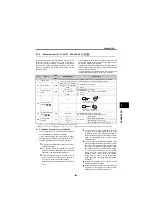
251
2
P
ARAM
ETE
R
PARAMETER
(2) Optimum excitation control mode
[
Pr. 60 = 9
]
Optimum excitation control is a control method which
controls excitation current to improve the motor
efficiency to maximum and determines output
voltage.
1) Control method
By converting the motor current to d-q axis to find
the excitation current Id and torque current Iq,
then obtain the motor loss by an original method.
Since application is fan and pump, low speed
torque is not required. Therefore, it controls
excitation current Id to make the motor loss
minimum focusing on the improvement of motor
efficiency rather than torque generation.
Namely, it controls the ratio of the excitation
current Id and torque current Iq becomes
maximum efficiency of the motor.
2) Restrictions
• Since it automatically sets the output voltage to
V/F control, the output voltage is not as set in [
Pr.
0 Torque boost
] and [
Pr. 14 Load pattern selection
].
• When the motor capacity is too small as
compared to the inverter capacity or two or more
motors are connected to one inverter, the energy
saving effect is not expected.
• Optimum excitation control functions only during
V/F control. Optimum excitation control is
disabled when Simple magnetic vector control,
Advanced magnetic vector control or General-
purpose magnetic vector control are selected.
3) Dedicated parameters
Dedicated parameters to automatically set the
output voltage are not available.
4) Energy-saving effect
• Motor efficiency improvement example (when
inverter operation frequency is 60Hz and the FR-
F740-3.7K and motor SF-JR 4P3.7kW are used)
• The motor efficiency has further improved by the
optimum excitation control and it is economical.
• The energy-saving effect of the FR-F700 has
increased even during acceleration/deceleration
as compared to the FR-F500.
• Ex. of blower operation characteristics (discharge
side)
(when the V/F pattern is constant torque load [
Pr.
14 = 0
])
• The optimum excitation control reduces the
motor loss to further save power consumption,
and it is economical.
When the inverter running frequency is 20Hz
• The optimum excitation control has reduced
approx.45% of the power consumption ratio as
compared to the V/F control method.
• Approx. 5% of the power consumption ratio has
been reduced as compared to the energy-saving
mode.
F700
E700
D700
Excitation current
I d
I q
Torque current
Output torque
0
20
40
80
60
Motor load torque (%)
100
20
40
60
80
100
Motor ef
ficiency (%)
V/F control
Energy-saving mode
Optimum excitation control
When the motor load torque is 10%
Control Method
Motor Efficiency
Conventional V/F mode
Approx. 65%
Energy-saving mode
Approx. 75%
Optimum excitation control
Approx. 80%
The motor efficiency has increased approx. 15%
by the optimum excitation control as compared
to conventional V/F control.
6
㧑
0
10
20
30
40
50
90
100
Motor Lord Torque (%)
Ratio of Motor Power Consumption during Acc./Dec.
Power Consumption Ratio (%)
(Driving of the Mitsubishi 400V
4 poles 45kW motors comparison)
FR-F700
Conventional model(FR-F500)
12
㧑
0
10 20
40
30
Frequency (Hz)
50
20
40
60
80
100
Power Consumption (%)
60
Optimum
excitation
control
Energy
saving
mode
V/F control
Commercial
power
operation
Summary of Contents for FR-A700 Series
Page 245: ...279 2 PARAMETER PARAMETER MEMO ...
Page 440: ...474 PARAMETER MEMO ...
Page 522: ...556 SELECTION MEMO ...






























